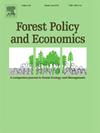Marketing of NTFPs by forest-dependent communities in Maharashtra, India: Alternative models for state support
IF 3.8
2区 农林科学
Q1 ECONOMICS
引用次数: 0
Abstract
Studies show that forest dependent communities (FDCs) can improve economic outcomes through community-based forest enterprises (CFEs) based on timber harvest and sale. In India, since FDCs do not have rights to timber even under decentralization laws, they must rely on unpredictable non-timber forest product (NTFP) markets for economic benefits. Additionally, their enterprises would have to compete with pre-existing well-funded state-assisted NTFP marketing institutions. Few studies have focused on CFE performance under such challenging conditions. Recently, FDCs in Maharashtra (India) have formed ‘Village Federations (VFs)’ specially for marketing an important NTFP: tendu (Diospyros melanoxylon) leaves. In this study, we ask whether small-scale, self-financed VFs improve economic outcomes for FDCs as compared to state-assisted NTFP marketing institutions, and what key operational choices lead to those outcomes. We conduct a multi-dimensional assessment of economic outcomes including price and quantity of leaves sold, proportion-timing-accessibility of payments, administrative costs, creation of buffer funds; and compare two VFs and two state-assisted marketing institutions. We find that VFs consistently secured higher prices, enabled faster payments, lowered administrative costs, and created community buffer funds in contrast to the state-assisted models. VFs achieved this through more efficient leaf production, and better management of leaf collection centers, among other measures, to improve operations. The underlying reason for VFs being able to improve operations is that their sole purpose is marketing NTFPs and, unlike the state-assisted counterparts, they are unhindered by other objectives. Further studies can help identify financial and institutional pathways to strengthen VFs and their impact on forest-dependent communities.
印度马哈拉施特拉邦依赖森林的社区销售非森林保护区:国家支持的替代模式
研究表明,森林依赖型社区(fdc)可以通过以木材采伐和销售为基础的社区森林企业(CFEs)改善经济成果。在印度,由于森林发展中国家即使根据权力下放法也没有木材权利,它们必须依靠不可预测的非木材林产品市场来获得经济利益。此外,他们的企业将不得不与已有的资金充足的国家资助的NTFP营销机构竞争。很少有研究关注CFE在如此具有挑战性的条件下的表现。最近,马哈拉施特拉邦(印度)的森林种植中心成立了“村联合会”,专门用于销售一种重要的非热带植物保护食品:腾度(黑梭梭)叶。在本研究中,我们探讨了与国家资助的NTFP营销机构相比,小规模、自筹资金的VFs是否改善了fdc的经济成果,以及哪些关键的运营选择导致了这些结果。我们对经济成果进行多维度评估,包括销售树叶的价格和数量、付款的比例-时间-可及性、行政成本、缓冲基金的创建;并比较两个VFs和两个国家资助的营销机构。我们发现,与国家资助的模式相比,虚拟货币始终能够确保更高的价格,实现更快的支付,降低管理成本,并创建社区缓冲基金。VFs通过更有效的叶片生产和更好的叶片收集中心管理以及其他措施来改善运营,实现了这一目标。虚拟货币基金能够改进业务的根本原因是,它们的唯一目的是推销国家森林产品,与国家援助的对口单位不同,它们不受其他目标的阻碍。进一步的研究可以帮助确定财政和体制途径,以加强生态多样性及其对依赖森林的社区的影响。
本文章由计算机程序翻译,如有差异,请以英文原文为准。
求助全文
约1分钟内获得全文
求助全文
来源期刊

Forest Policy and Economics
农林科学-林学
CiteScore
9.00
自引率
7.50%
发文量
148
审稿时长
21.9 weeks
期刊介绍:
Forest Policy and Economics is a leading scientific journal that publishes peer-reviewed policy and economics research relating to forests, forested landscapes, forest-related industries, and other forest-relevant land uses. It also welcomes contributions from other social sciences and humanities perspectives that make clear theoretical, conceptual and methodological contributions to the existing state-of-the-art literature on forests and related land use systems. These disciplines include, but are not limited to, sociology, anthropology, human geography, history, jurisprudence, planning, development studies, and psychology research on forests. Forest Policy and Economics is global in scope and publishes multiple article types of high scientific standard. Acceptance for publication is subject to a double-blind peer-review process.
 求助内容:
求助内容: 应助结果提醒方式:
应助结果提醒方式:


